Femtosecond Lasers
Definition: lasers emitting light pulses with durations between a few femtoseconds and hundreds of femtoseconds
Alternative term: ultrafast lasers
More general term: mode-locked lasers
German: Femtosekundenlaser
Categories: lasers, light pulses
How to cite the article; suggest additional literature
Author: Dr. Rüdiger Paschotta
A femtosecond laser is a laser which emits optical pulses with a duration well below 1 ps (→ ultrashort pulses), i.e., in the domain of femtoseconds (1 fs = 10−15 s). It thus also belongs to the category of ultrafast lasers or ultrashort pulse lasers (which also include picosecond lasers).
The generation of such short (sub-picosecond) light pulses is nearly always achieved with the technique of passive mode locking. That leads to pulses with moderate pulse energies (often in the nanojoule region) and high pulse repetition rates in the megahertz or gigahertz region. Far higher pulse energies (at lower repetition rates) are possible by using some kind of optical amplifiers system (→ ultrafast amplifiers) in addition to a femtosecond laser.
Types of Femtosecond Lasers
Femtosecond pulses can be generated with very different kinds of lasers, which are explained in the following.
Solid-state Bulk Lasers
Passively mode-locked solid-state bulk lasers can emit high-quality ultrashort pulses with typical durations between 30 fs and 30 ps. Various diode-pumped lasers, e.g. based on neodymium-doped or ytterbium-doped gain media, operate in this regime, with typical average output powers between ≈ 100 mW and 1 W. Titanium–sapphire lasers with advanced dispersion compensation are suitable for particularly short pulse durations below 10 fs, in extreme cases down to approximately 5 fs.
The pulse repetition rate is in most cases between 50 MHz and 500 MHz, even though there are low repetition rate versions with a few megahertz for higher pulse energies, and also miniature lasers with tens of gigahertz.
Fiber Lasers
Various types of ultrafast fiber lasers, which are also in most cases passively mode-locked, typically offer pulse durations between 50 and 500 fs, repetition rates between 10 and 100 MHz, and average powers of a few milliwatts. Substantially higher average powers and pulse energies are possible, e.g. with stretched-pulse fiber lasers or with similariton lasers, or in combination with a fiber amplifier.
All-fiber solutions can be fairly cost-effective in mass production, although the effort required for development of a product with high performance and reliable operation can be substantial due to various technical challenges – in particular, the handling of the strong optical nonlinearities.
Dye Lasers
Dye lasers dominated the field of ultrashort pulse generation before the advent of titanium–sapphire lasers in the late 1980s. Their gain bandwidth allows for pulse durations of the order of 10 fs, and different laser dyes are suitable for emission at various wavelengths, often in the visible spectral range. Mainly due to the disadvantages associated with handling a laser dye and the limited dye lifetime, femtosecond dye lasers are no longer frequently used.
Semiconductor Lasers
Some mode-locked diode lasers can generate pulses with femtosecond durations. Directly at the laser output, the pulses durations are usually at least several hundred femtoseconds, but with external pulse compression, much shorter pulse durations can be achieved. Mode-locked semiconductor lasers are also suitable for very high pulse repetition rates, e.g. tens or even hundreds of gigahertz. In most cases, however, the pulse energy is several limited to the picojoule region.
It is also possible to passively mode-lock vertical external-cavity surface-emitting lasers (VECSELs); these are interesting particularly because they can deliver a combination of short pulse durations, high pulse repetition rates, and sometimes high average output power. Their pulse energies can be much higher than for edge-emitting diode lasers, but still much lower than for solid-state bulk lasers in particular.
Other Types
More exotic types of femtosecond lasers are color center lasers and free electron lasers. The latter can be made to emit femtosecond pulses even in the form of X-rays.
Important Parameters of Femtosecond Lasers
The key performance figures of femtosecond lasers are the following:
- the pulse duration (which is mostly fixed, but in some cases tunable in a certain range)
- the pulse repetition rate (which is in most cases fixed, or tunable only within a small range)
- the average output power and pulse energy
There are, however, various additional aspects which can be important:
- The time–bandwidth product (TBP) shows whether the spectral width is larger than necessary for the given pulse duration. The pulse quality includes additional aspects such as details of the temporal and spectral pulse shape, such as the presence of temporal or spectral pedestals or side lobes.
- Many femtosecond lasers offer a stable linear polarization of the output, whereas others emit with an undefined polarization state.
- The noise properties can differ strongly between different types and models of femtosecond lasers. This includes noise of the pulse timing (→ timing jitter), the pulse energy (→ intensity noise), and different types of phase noise. It may also be important to check the stability of pulse parameters, including the sensitivity of external influences such as mechanical vibrations or optical feedback.
- Some lasers have built-in means for stabilizing the pulse repetition rate to an external reference, or for tuning the output wavelength.
- The laser output can be delivered into free space e.g. through some optical window in the housing, or via a fiber connector.
- Built-in features for monitoring the output power, wavelength, or pulse duration, can be convenient.
- Other aspects of potential interest are the size of the housing, the electrical power consumption, the cooling requirements, and interfaces for synchronization or computer control.
Apart from these aspects of the laser itself, the quality of the documentation material, such as product specifications, user manual, etc., can be of interest.
Suppliers
The RP Photonics Buyer's Guide contains 81 suppliers for femtosecond lasers. Among them:

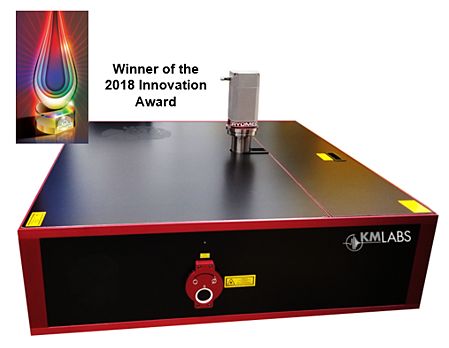
Kapteyn-Murnane Laboratories
KMLabs is the only commercial provider for comprehensive, end-to-end research systems that leverage ultrafast pulses of extreme UV and soft X-ray light for a variety of experiments. The QM Quantum Microscope™ builds on the company’s world leading technology in high harmonic generation to enable a range of techniques including coherent diffraction imaging, photoemission, pump–probe spectroscopy, and EUV metrology. In addition, KMLabs continues to pioneer the development and engineering of standalone short wavelength sources including the Hyperion VUV laboratory-based vacuum ultraviolet femtosecond laser source, and the Pantheon™ platform, a pulsed EUV source-beamline to generate and deliver EUV photons to user-supplied experimental stations.

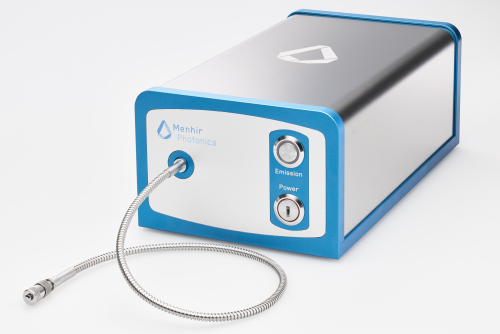
Menhir Photonics
Menhir Photonics offers ultrafast mode-locked lasers at 1.5 μm wavelength. These lasers offer pulse width below 200 fs and fundamental pulse repetition rates that can be chosen from 250 MHz up to 2.5 GHz. These systems are hermetically sealed and all-in-one (laser and electronic is one box). Menhir Photonics’ products have been designed to achieve ultra-low-noise performances combined with high-reliability and robustness, to ensure that they can be used in any situation from laboratory setup to harsh environments.

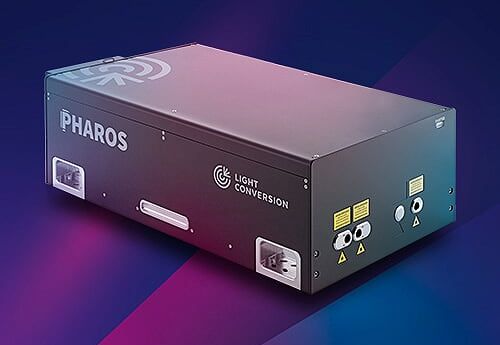
Light Conversion
The PHAROS is a femtosecond laser system combining millijoule pulse energies and high average powers. PHAROS features a mechanical and optical design optimized for industrial applications such as precise material processing. Compact size, integrated thermal stabilization system and sealed design allow PHAROS integration into machining workstations. The use of solid state laser diodes for pumping of Yb medium significantly reduces maintenance cost and provides long laser lifetime.
Tunable PHAROS parameters include: pulse duration (190 fs – 20 ps), repetition rate (single pulse to 1 MHz), pulse energy (up to 2 mJ) and average power (up to 20 W). Its deliverable power is sufficient for most of material processing applications at high machining speeds. The built-in pulse picker allows convenient control of the laser output in pulse on demand mode. The compact and robust optomechanical design features of PHAROS lead to stable laser operation in varying environments.
The PHAROS laser can be equipped with automated harmonics modules. A selection of fundamental (1030 nm), second (515 nm), third (343 nm), fourth (257 nm) or fifth (206 nm) harmonic outputs are available through software control.
Harmonics generators are designed to be used in industrial applications where a single output wavelength is desired. Modules are mounted directly on the output of the laser and integrated into the system.
PHAROS has an option for tunable GHz and MHz burst with burst-in-burst capability – called BiBurst. The distance between burst packet groups is called nanosecond burst, N (MHz-Burst). The distance between sub-pulses in the group is called picosecond burst, P (GHz-Burst). In single pulse mode, one pulse is emitted at a time at some fixed frequency. In burst mode, the output consists of several picosecond burst packets each separated by an equal time period between each packet. Each packet can contain a number of sub-pulses which are also separated by an equal time period between each pulse.
High pulse energy femtosecond laser with flexible BiBurst functionality brings new production capabilities to high-tech manufacturing industries such as consumer electronics, integrated photonic chip manufacturing, stent cutting, surface functionalization, future displays manufacturing and quantum computing.
BiBurst material fabrication areas cover:
- brittle material drilling and cutting
- deep engraving
- selective ablation
- transparent materials volume modification
- hidden marking
- surface functional structuring

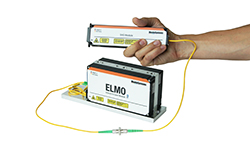
Menlo Systems
Menlo Systems' femtosecond fiber lasers based on Menlo figure 9® patented laser technology are unique in regard to user-friendliness and robustness. We offer solutions for scientific research as well as laser models engineered for OEM integration. From the shortest pulses to highest average power beyond 10 Watts and pulse energy beyond 10 μJ, we have the solution for your application ranging from basic research to industrial applications in spectroscopy, quality control, and material processing.
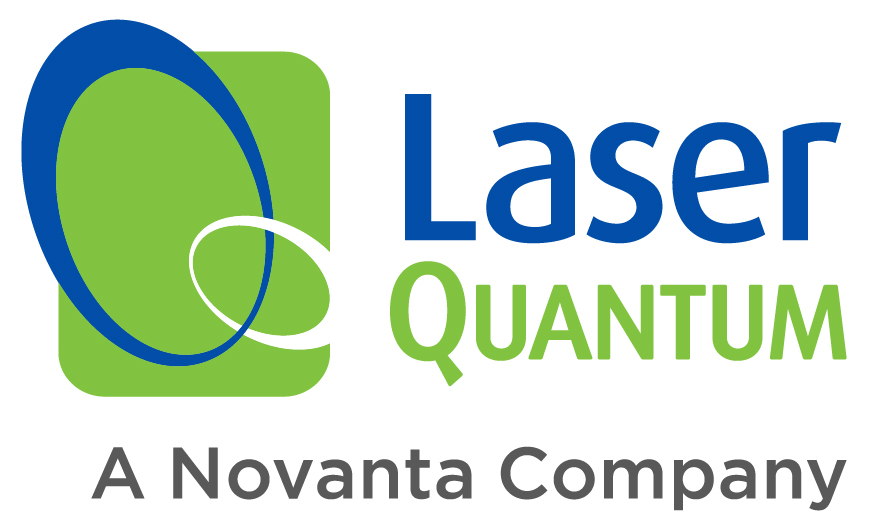

Laser Quantum
Laser Quantum specialise in femtosecond laser systems with ultra-short pulses and high repetition rates that offer unique capabilities and benefits to a wide variety of scientific applications.


TOPTICA Photonics
With more than 15 years of experience, TOPTICA provides high-repetitive femtosecond lasers based on erbium- and ytterbium fiber laser technology. TOPTICA offers systems for OEM integrators as well as customized solutions for scientific customers, ranging from compact fiber-based seeders / oscillators to custom-tailored high-power amplifiers.

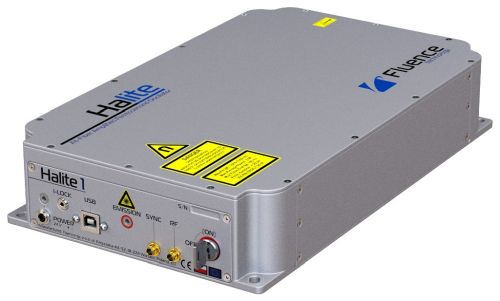
Fluence
Halite is a compact, single-box, all-fiber femtosecond laser, specifically designed to meet the most demanding applications in the field of neuroscience, biophotonics, microscopy and engineering. With pulses as short as <180 fs, average power up to 2 W at 1030 nm and the option of second harmonic generation at 515 nm, it is an irreplaceable tool in every lab that needs a reliable, turn-key, ultrafast light source. Thanks to its unique construction and SESAM-free technology it is a cost-effective solution that provides high pulse energy (up to 100 nJ) and an excellent beam quality. Halite’s industrial design facilitates easy integration with both experimental and commercial systems.


NKT Photonics
Origami is our ultra-stable passively mode-locked laser platform, it exhibits the lowest phase noise on the market. A special hybrid laser setup, consisting of state-of-the-art polarization maintaining (PM) fiber technology and free-space sections for advanced dispersion control, allows for high pulse energy generation while supporting perfectly transform-limited soliton pulses without spectral ripples, excess of optical bandwidth, Kelly-sidebands, temporal pedestals or satellite pulses. The Origami lasers are designed for all precision applications, scientific or industrial, requiring long-term amplitude stability, low phase noise and timing jitter, compact and rugged design and 24/7 maintenance-free operation.


RPMC Lasers
RPMC Lasers offers mode locked femtosecond fiber lasers from 400 fs down to <140 fs, with average powers up to 50 W and wavelengths of 1040, 1035, 920 and 515 nm.


EKSPLA
EKSPLA offers a wide range of femtosecond lasers for various applications:
- FemtoLux3 series microjoule class industrial fiber laser
- Ultraflux series femtosecond tunable wavelength laser based on the novel OPCPA technology
- FF200 series compact fiber laser

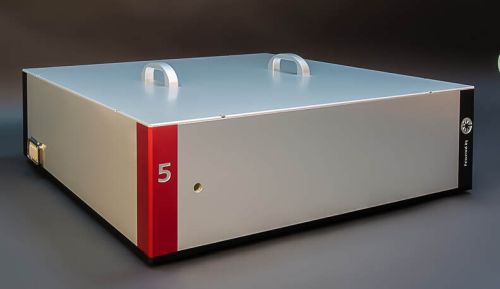
Class 5 Photonics
Class 5 Photonics offer powerful and high-performance femtosecond lasers based on optical parametric chirped pulse amplification (OPCPA):
- 5 W to 100 W average power for demanding applications
- pulse duration from 100 fs down to 9 fs
- pumped by industrial Yb:fiber or Yb:YAG amplifiers
- CEP stability available
- add-ons: EUV to MID-IR wavelength extension
Extreme power at extreme wavelengths with award-winning products serving the ultrafast community with wavelengths ranging from high-flux extreme-ultraviolet (XUV) to high-field Terahertz – enabling researchers in physics, chemistry, and biology to conduct outstanding research at the frontiers of their fields.
Questions and Comments from Users
Here you can submit questions and comments. As far as they get accepted by the author, they will appear above this paragraph together with the author’s answer. The author will decide on acceptance based on certain criteria. Essentially, the issue must be of sufficiently broad interest.
Please do not enter personal data here; we would otherwise delete it soon. (See also our privacy declaration.) If you wish to receive personal feedback or consultancy from the author, please contact him e.g. via e-mail.
By submitting the information, you give your consent to the potential publication of your inputs on our website according to our rules. (If you later retract your consent, we will delete those inputs.) As your inputs are first reviewed by the author, they may be published with some delay.
Bibliography
| [1] | F. Krausz et al., “Femtosecond solid-state lasers”, IEEE J. Quantum Electron. 28 (10), 2097 (1992), doi:10.1109/3.159520 |
| [2] | D. H. Sutter et al., “Semiconductor saturable-absorber mirror-assisted Kerr lens modelocked Ti:sapphire laser producing pulses in the two-cycle regime”, Opt. Lett. 24 (9), 631 (1999), doi:10.1364/OL.24.000631 |
| [3] | U. Morgner et al., “Sub-two cycle pulses from a Kerr-lens mode-locked Ti:sapphire laser”, Opt. Lett. 24 (6), 411 (1999), doi:10.1364/OL.24.000411 |
| [4] | S. V. Marchese et al., “Pulse energy scaling to 5 μJ from a femtosecond thin-disk laser”, Opt. Lett. 31 (18), 2728 (2006), doi:10.1364/OL.31.002728 |
| [5] | C. J. Saraceno et al., “Ultrafast thin-disk laser with 80 μJ pulse energy and 242 W of average power”, Opt. Lett. 39 (1), 9 (2014), doi:10.1364/OL.39.000009 |
| [6] | T. Nubbemeyer et al., “1 kW, 200 mJ picosecond thin-disk laser system”, Opt. Lett. 42 (7), 1381 (2017), doi:10.1364/OL.42.001381 |
| [7] | M. E. Fermann, “Ultrafast fiber oscillators”, in Ultrafast Lasers: Technology and Applications (eds. M. E. Fermann, A. Galvanauskas, G. Sucha), Marcel Dekker, New York (2003), Chapter 3, pp. 89–154 |
| [8] | R. Paschotta and U. Keller, “Passively mode-locked solid-state lasers”, in Solid-State Lasers and Applications (ed. A. Sennaroglu), CRC Press, Taylor and Francis Group, LLC (2007), Chapter 7, pp. 259–318 |
See also: mode-locked lasers, ultrafast lasers, mode-locked diode lasers, titanium–sapphire lasers, solid-state lasers, picosecond lasers, passive mode locking, mode locking, ultrashort pulses
and other articles in the categories lasers, light pulses
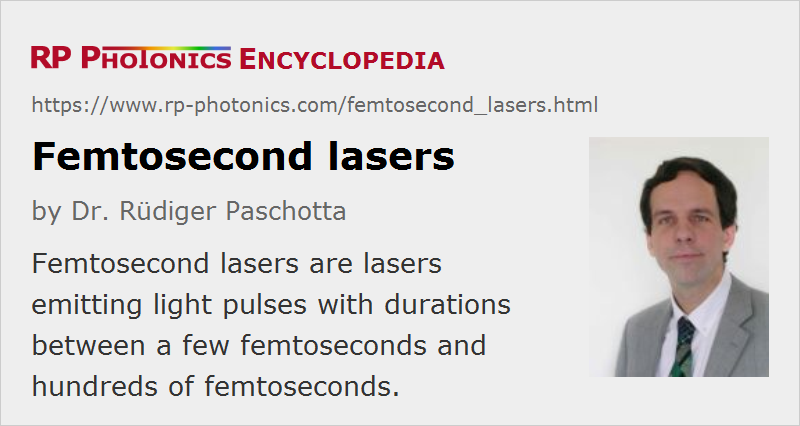 |





If you like this page, please share the link with your friends and colleagues, e.g. via social media:
These sharing buttons are implemented in a privacy-friendly way!